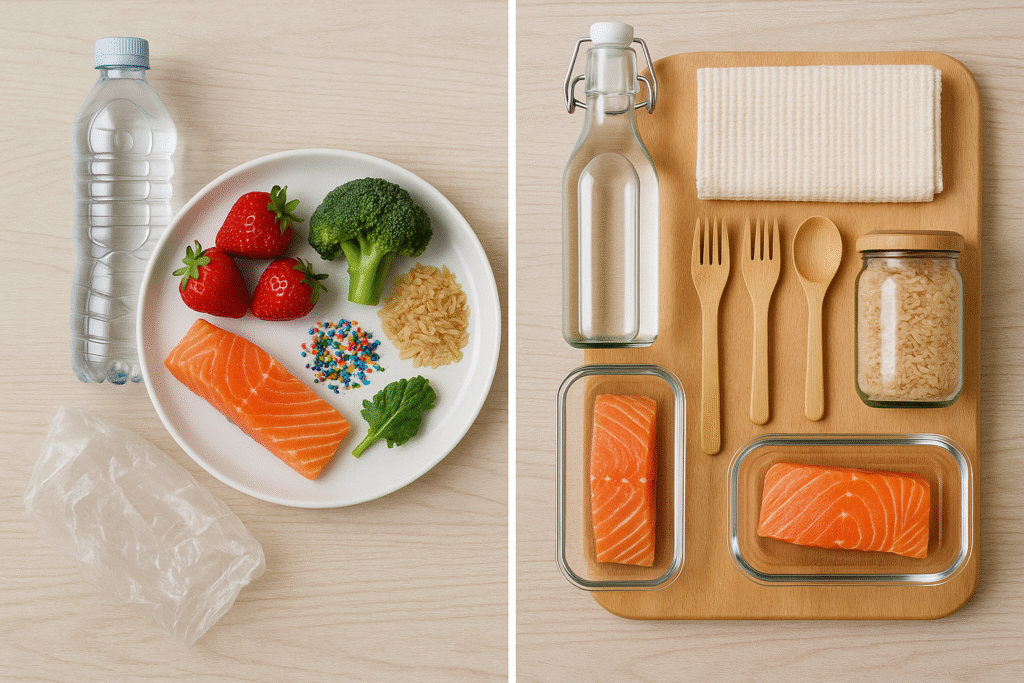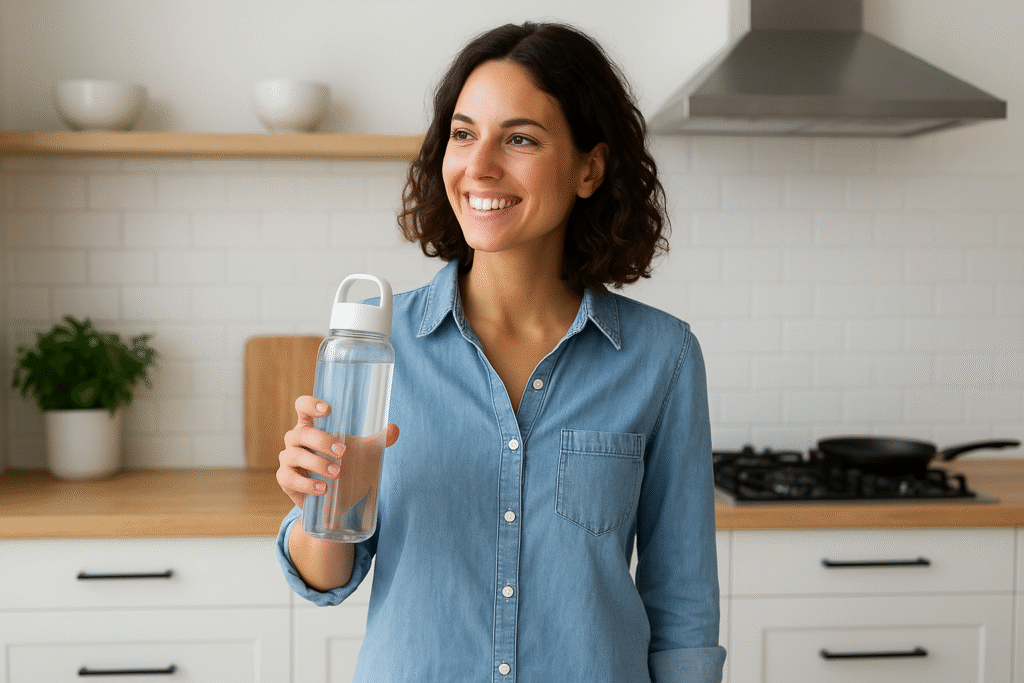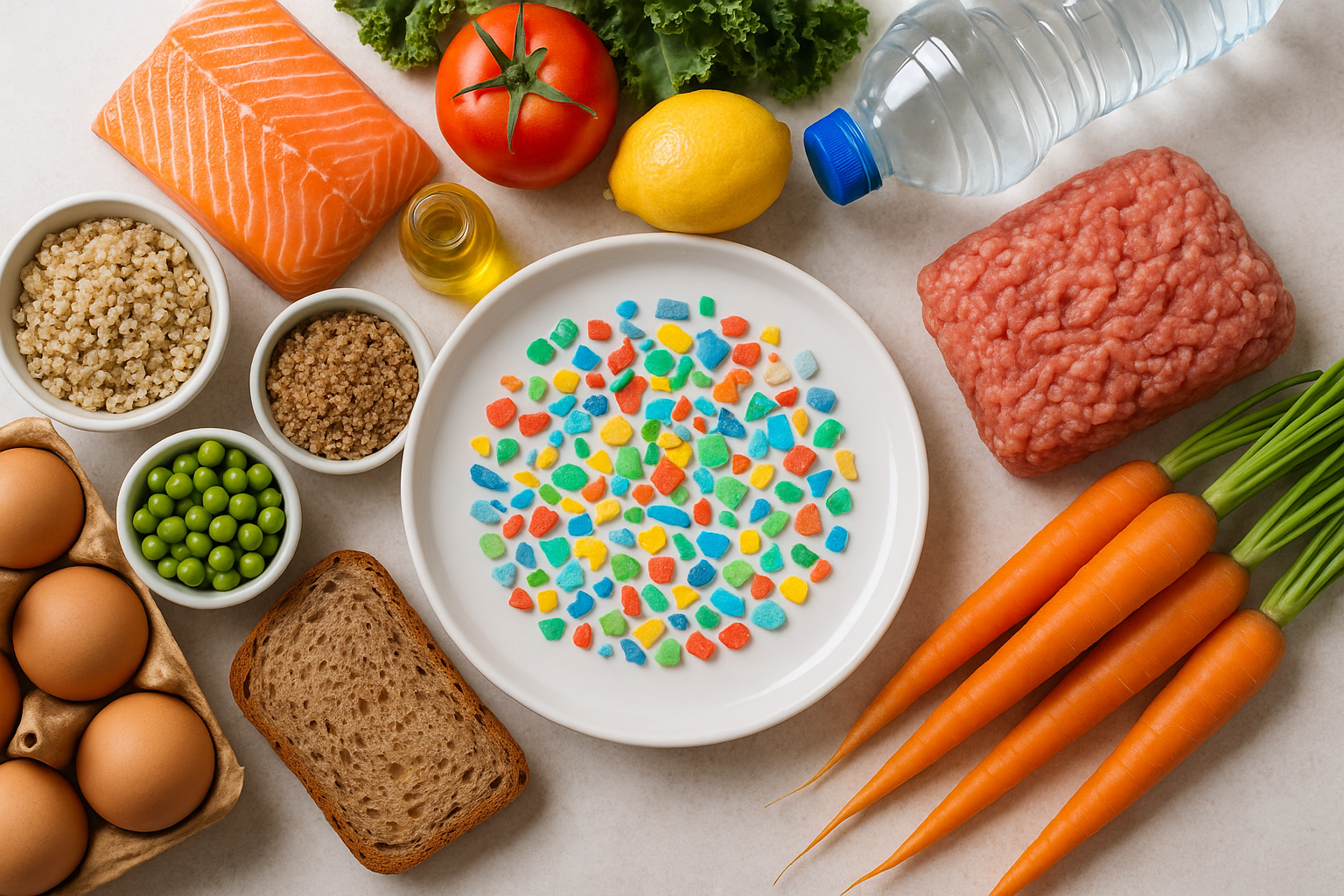Microplastics in Food: Tiny plastics are turning up in foods and drinks worldwide. Scientists have found microplastics in seafood, salt, bottled water and even in human tissues — and while the health picture is still emerging, smart kitchen choices can reduce your personal exposure today. This practical guide (Global + US + UK focus) explains how plastics get into food, what the evidence says in 2024–2025, and 11 easy, evidence-based swaps and habits you can adopt this week to lower your intake.
Quick snapshot — why this matters now
- Microplastics (generally defined as plastic particles <5 mm) are widespread in the environment — in oceans, soils, air and water — and have been detected in human food and even human tissues. The World Health Organization has reviewed the evidence and concluded that microplastics are ubiquitous but that more research is urgently needed to understand health risks. (World Health Organization, WHO CDN)
- Recent studies show very large numbers of tiny plastic particles in some foods and beverages. For example, a 2024 study summarized by NIH/NIH news found bottled water samples contained hundreds of thousands of plastic particles per litre on average — far higher than earlier estimates. Seafood and shellfish (especially species eaten whole) also show measurable microplastic loads; top shellfish consumers may ingest thousands to tens of thousands of particles per year from seafood alone in some estimates. (National Institutes of Health (NIH), PMC)
What this means: microplastics in food are real and widespread, but whether current exposures cause specific health harms in humans — and at what levels — remains the subject of active research and regulatory review. That uncertainty makes sensible exposure reduction a pragmatic, low-risk strategy while scientists close the knowledge gaps. (World Health Organization)
How do microplastics get into our food? (short, clear primer)
Microplastics can enter food at many points along the chain:
- Environmental contamination: plastic particles in seawater and sediments are taken up by fish, shellfish and sea salt; soils contaminated with plastics can transfer particles to crops.
- Processing and packaging: plastic processing equipment, conveyor belts, film liners and bottle caps can shed particles during production, filling and storage. Recent research has shown some surprising sources — e.g., polyester paint on metal bottle caps — that contribute particles to beverages. (Food & Wine)
- Kitchen handling and heating: heating food in plastic containers, scraping or using worn plastic cutting boards, and repetitive use of plastic wrap or reusing single-use containers can increase microplastic shedding into food.
- Drinking water supply and bottled water: microplastics enter water systems and bottled water at detectable concentrations; bottled water studies have reported especially high particle counts in some samples. (National Institutes of Health (NIH))
Because the pathways are multiple, reducing exposure requires a mix of source-control (choose alternatives to plastic where practical), processing-awareness (choose less-processed foods) and safe kitchen habits.
What does the science say about health risk?
Short answer: we don’t yet know the full human health impact. Major public-health bodies and food-safety agencies acknowledge the ubiquity of microplastics but also highlight important gaps:
- WHO (and linked expert assessments): consolidated evidence shows microplastics are globally widespread and detectable in food and the human body, but current evidence is insufficient to quantify human health risks robustly; WHO calls for more standardised measurement methods and toxicological studies. (World Health Organization)
- Regulatory agencies (FDA / EFSA / UK bodies): regulators are monitoring the science and integrating microplastics into contaminant and food-contact assessments. The U.S. FDA notes there are no authorised microplastics as food ingredients and that plastics used in contact with food must be approved; agencies emphasise monitoring and research while continuing to enforce material-safety rules. (U.S. Food and Drug Administration, European Food Safety Authority)
Scientific studies give useful exposure estimates (e.g., bottled water and shellfish particle counts) but differ in methods and particle size ranges, making direct risk conclusions hard. That means sensible mitigation — reducing avoidable exposure now — is a reasonable precaution while research continues.

11 practical kitchen swaps & habits to reduce Microplastics in Food
These are inexpensive, low-friction changes you can adopt one at a time. Each swap reduces a known pathway for microplastic contamination.
1. Stop microwaving food in single-use plastic containers
Heat increases plastic migration and shedding. Use glass, ceramic, or microwave-safe porcelain dishes instead. When you must use plastic, ensure it is explicitly microwave-safe and avoid high-fat foods and long heating times.
2. Choose reusable bottles and avoid single-use bottled water where possible
Tap water filtered with a quality home filter (see #6) is usually cheaper and reduces reliance on plastic bottles. Recent studies show bottled water can contain high particle counts; reducing bottled-water use limits ingestion from that source. (National Institutes of Health (NIH))
3. Prefer stainless steel, glass or ceramic food storage & cookware
Swap cling film and many plastic tubs for glass containers with silicone or stainless lids. Glass and stainless resist abrasion and heat-induced shedding.
4. Replace worn plastic cutting boards and utensils
Deeply scored plastic boards shed more particles. Use bamboo, hardwood (well-maintained), or tempered glass boards for chopping. For utensils, stainless steel spoons and spatulas are durable and non-shedding.
5. Avoid chewing or cooking with plastic-coated bottle caps: remove cap residues
Recent studies identified polyester paint on caps as a source of particles in bottled beverages. If you drink from capped bottles, wiping caps or transferring contents to a glass reduces exposure. (Food & Wine)
6. Use a good-quality water filter (and maintain it)
Some point-of-use water filters remove microplastics and microparticles better than plain tap flow. Choose filters rated to remove particles down to the micrometer range (check manufacturer specs) and replace cartridges per schedule.
7. Reduce heavily processed and pre-packaged foods when possible
Processing lines and packaging introduce opportunities for contamination. A diet richer in minimally processed whole foods (fresh veggies, legumes, whole grains) typically uses less plastic contact.
8. Be cautious with canned foods (liners) and heat-exposed plastics
Acidic foods (tomato, citrus) may interact with can liners. Use alternatives (glass-bottled sauces) when convenient and avoid reheating food inside lined cans.
9. Dry your synthetic-fabric clothes outside or use collection filters in your washer
While this isn’t a kitchen swap per se, synthetic fibres shed during washing and end up in wastewater and the food chain. Using a microfibre-capture filter in your washing machine reduces shedding into waterways that can contaminate seafood.
10. Avoid abrasive ‘magic’ sponges on non-stick or plastic surfaces without rinsing well
Some cleaning products and methods can release microfibers. Switch to loofahs, natural sponges, or denser (lower-shedding) alternatives and rinse surfaces thoroughly.
11. Store food away from dusty or plastic-heavy environments
Household dust contains microplastic fibres. Keep stored dry goods in sealed glass jars and wipe pantry shelves to minimise settled dust particles.
Food-by-food quick checklist (what to watch and easy fixes)
- Bottled water: Reduce use; prefer filtered tap water in glass/stainless. (National Institutes of Health (NIH))
- Seafood & shellfish: Buy from trusted sources, rinse shellfish, consider cooking methods that reduce ingestion of gut content (for whole-shellfish eaters, depuration and source matters). Shellfish like mussels/oysters eaten whole can contain higher particle loads. (PMC)
- Salt: Some table salts contain microplastics — choose lower-processed salts or specialist-tested brands if worried.
- Beverages in glass bottles: Be aware caps/linings can be a source — pouring into a glass helps. (Food & Wine)
- Packaged/processed snacks: Often handled and packaged in plastic — prefer bulk dispensers with your own container where available.
- Takeaway food: Avoid greasy foods in plastic containers; transfer to your own dish where possible.

How to prioritise changes (a simple 30-day plan)
Week 1 — small fast wins
- Stop microwaving in plastic, replace one plastic container with glass, buy a reusable stainless bottle.
Week 2 — reduce bottled water and add a filter
- Install a simple pitcher or under-sink filter; transfer bottled drinks into glass.
Week 3 — kitchen swap & cleaning change
- Replace cutting board/utensils or deep-clean existing plastic tools and avoid abrasive sponges.
Week 4 — food choices & washcare
- Reduce processed packaged foods by one meal a day and add a washing-machine microfibre filter to reduce environmental shedding.
Track one habit at a time — little changes compound.
What regulators recommend (official guidance & where to read more)
Regulators and international bodies currently emphasise monitoring, standardized measurement and more research — while offering practical consumer guidance:
- World Health Organization (WHO) — review of evidence and calls for more research on dietary and inhalation exposures. (World Health Organization)
- U.S. Food and Drug Administration (FDA) — overview of microplastics and nanoplastics in foods and food contact materials; clarifies that microplastics are not authorised food ingredients and explains regulatory approaches. (U.S. Food and Drug Administration)
- European Food Safety Authority (EFSA) / national food-safety agencies — evaluating food contact materials and the need for robust migration and exposure data; EFSA oversees food-contact material safety assessments in the EU. (European Food Safety Authority)
- UK Food Standards Agency (FSA) and Committee on Toxicity documents — critical reviews and sub-statements on oral and inhalation routes of microplastic exposure; the UK has commissioned and published in-depth reviews. (Food Standards Agency, cot.food.gov.uk)
(Links to these authorities are provided in the resource list below.)
Bottom line: act sensibly, avoid alarmism
Microplastics in food are a genuine exposure pathway and science shows measurable numbers in water, seafood and packaged foods. But regulators and WHO stress that the evidence linking typical dietary exposure to specific health outcomes in humans is still incomplete. That means:
- Don’t panic — instead take practical, low-cost steps to cut avoidable exposure (the 11 swaps above).
- Support better policy — vote with your wallet and your voice for reduced single-use plastics, improved packaging standards and more research funding.
- Stay informed — as science improves, guidance will evolve; reputable agencies will publish updates.
Trusted government & authoritative links (openable)
- WHO — Dietary and inhalation exposure to nano- and micro-plastic particles (WHO project & materials).
https://www.who.int/publications/i/item/9789240054608. (World Health Organization) - U.S. FDA — Microplastics and nanoplastics in foods (overview and regulatory context).
https://www.fda.gov/food/environmental-contaminants-food/microplastics-and-nanoplastics-foods. (U.S. Food and Drug Administration) - EFSA — Food contact materials (topic page: migration and safety of materials contacting food).
https://www.efsa.europa.eu/en/topics/topic/food-contact-materials. (European Food Safety Authority) - UK Food Standards Agency — A critical review of microbiological colonisation of nano- and microplastics and their significance to the food chain (FSA research).
https://www.food.gov.uk/research/foodborne-disease/a-critical-review-of-microbiological-colonisation-of-nano-and-microplastics-nmps-and-their-significance-to-the-food-chain. (Food Standards Agency) - NIH / Paper summary on microplastics in bottled water (study summary) — background on bottled-water particle findings.
https://www.nih.gov/news-events/nih-research-matters/plastic-particles-bottled-water. (National Institutes of Health (NIH))
Quick FAQ (final, practical answers)
Q: Will switching to glass eliminate microplastics?
A: Not entirely — glass reduces shedding from plastic foodware, but particles can come from other sources (caps, air, processing). Combined tactics (glass + filter + fewer processed foods) reduce overall exposure most effectively.
Q: Are there home devices that “remove microplastics” from water?
A: Some point-of-use filters trap particles in the micrometre range; look for particle-filtration specs. No common home device removes nanoplastics reliably — technology and standards are evolving.
Q: Should I stop eating seafood?
A: No — seafood provides important nutrients. Choose lower-contaminant species when possible, vary sources, and balance benefits vs. potential microplastic exposure. For people consuming shellfish whole, occasional moderation and sourcing from cleaner waters can help.
Disclaimer
This article is educational and not medical or regulatory advice. It summarises current scientific understanding and official guidance as of publication and links to government and international resources for further detail. If you have health concerns related to environmental exposures, consult your healthcare provider or local public-health authority. Official sources linked above contain more technical and up-to-date guidance. All images used in this article are royalty‑free or licensed for commercial use and are provided here for illustrative purposes.
